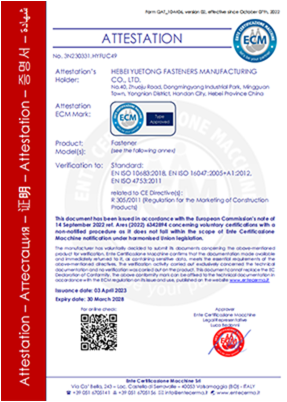Ott . 17, 2024 23:02 Back to list
Various Types of Bolts Illustrated with Images for Easy Identification
Different Types of Bolts A Comprehensive Guide with Pictures
Bolts are essential fasteners that play a critical role in a variety of engineering and construction applications. They are used to hold objects together, providing strength and stability to a wide range of structures, from bridges and buildings to machinery and electronics. Understanding the different types of bolts is vital for anyone involved in construction, engineering, or DIY projects. This article explores various types of bolts, their characteristics, and applications, along with visual representations to aid in recognition.
1. Hex Bolts
Hex bolts are among the most common types of bolts used in construction and industrial applications. They have a hexagonal head, which allows for easy gripping with a wrench. Hex bolts are typically used with nuts and are available in various grades, making them suitable for a wide range of load-bearing applications.

2. Carriage Bolts
Carriage bolts are designed with a round head and a square neck that prevents them from turning once installed. These bolts are often used in wooden connections where a smooth surface is desired, such as in furniture assembly or deck building. The square neck grips the wood, ensuring a secure fit.

3. Lag Bolts
Lag bolts, or lag screws, are heavy-duty fasteners used primarily in wood applications. They have a thick shaft and coarse threads, providing exceptional holding power. Lag bolts are often used in construction for securing beams and heavy timbers, making them ideal for outdoor structures like decks and fences.

4. Machine Bolts
Machine bolts are used to connect metal parts and are characterized by their flat or raised heads and uniform threads. These bolts can be used with nuts or tapped holes and are typically found in machinery, automotive applications, and structural components. Their versatility makes them invaluable in many fields.
5. Shoulder Bolts
different types of bolts with pictures

Shoulder bolts, or stripper bolts, feature a smooth, unthreaded shoulder below the head that allows for rotational movement. They are commonly used in applications requiring pivoting or rotation, such as in machinery and automotive components.

6. Eye Bolts
Eye bolts have a looped head, allowing for the attachment of ropes or cables. These bolts are often used in rigging and lifting applications, making them crucial for securing loads in both marine and industrial environments. They can be found in a variety of sizes and materials, depending on the load requirements.

7. U-Bolts
U-bolts are shaped like the letter U and are primarily used to secure pipes or other round objects. They are commonly found in plumbing and automotive applications. U-bolts can be made from various materials, allowing for corrosion resistance in demanding environments.

8. J-Bolts
J-bolts are bent into a J shape and are often used in construction for anchoring purposes. They are typically embedded in concrete to provide a strong foundation for structures like fences or building frames.

Conclusion
Understanding the different types of bolts and their specific applications is crucial for anyone involved in construction, engineering, or DIY projects. Each type of bolt has its distinct characteristics that suit particular tasks, and choosing the right one is essential for ensuring the integrity and safety of a project. Whether you are working with wood, metal, or in unique environments, knowing which bolt to use can make all the difference. Always ensure to follow proper installation practices and consider load requirements to maximize the effectiveness of your fasteners.
By gaining a comprehensive understanding of these fasteners, you'll be well-equipped to tackle any project that requires bolting, ensuring durability and safety in your work.
-
sleeve-anchor-innovations-that-hebei-yuetong-fasteners-engineering-excellence
NewsAug.22,2025
-
screw-s-precision-engineering-for-global-industries
NewsAug.22,2025
-
hexagon-nut-that-high-quality-fasteners-from-hebei-yuetong
NewsAug.22,2025
-
clamp-that-high-quality-fastening-solutions-from-hebei-yuetong
NewsAug.22,2025
-
bolt-that-reliable-fasteners-from-hebei-yuetong
NewsAug.22,2025
-
anchor-bolt-that-premium-fasteners-for-secure-and-durable-installations
NewsAug.22,2025


